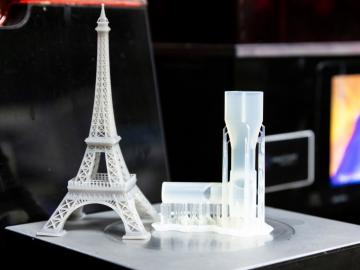
Filter News
Area of Research
- (-) Fusion and Fission (19)
- (-) Materials (76)
- (-) National Security (26)
- Advanced Manufacturing (1)
- Biological Systems (1)
- Biology and Environment (56)
- Building Technologies (1)
- Clean Energy (63)
- Computational Engineering (1)
- Computer Science (2)
- Electricity and Smart Grid (1)
- Energy Sciences (1)
- Fuel Cycle Science and Technology (1)
- Fusion Energy (3)
- Isotope Development and Production (1)
- Isotopes (15)
- Materials Characterization (2)
- Materials Under Extremes (1)
- Neutron Science (32)
- Nuclear Science and Technology (2)
- Supercomputing (73)
News Topics
- 3-D Printing/Advanced Manufacturing (5)
- Advanced Reactors (3)
- Artificial Intelligence (7)
- Big Data (1)
- Bioenergy (2)
- Biomedical (2)
- Buildings (3)
- Chemical Sciences (17)
- Climate Change (3)
- Composites (2)
- Computer Science (4)
- Coronavirus (1)
- Critical Materials (4)
- Cybersecurity (7)
- Decarbonization (6)
- Energy Storage (5)
- Environment (4)
- Exascale Computing (1)
- Frontier (1)
- Fusion (8)
- Grid (3)
- High-Performance Computing (4)
- Irradiation (1)
- Isotopes (4)
- Machine Learning (6)
- Materials (41)
- Materials Science (7)
- Microscopy (3)
- Molten Salt (1)
- Nanotechnology (3)
- National Security (14)
- Net Zero (2)
- Neutron Science (8)
- Nuclear Energy (15)
- Partnerships (10)
- Physics (9)
- Polymers (4)
- Quantum Computing (2)
- Quantum Science (1)
- Renewable Energy (1)
- Security (2)
- Simulation (3)
- Sustainable Energy (2)
- Transportation (3)
Media Contacts

A team of scientists with ORNL has investigated the behavior of hafnium oxide, or hafnia, because of its potential for use in novel semiconductor applications.

Speakers, scientific workshops, speed networking, a student poster showcase and more energized the Annual User Meeting of the Department of Energy’s Center for Nanophase Materials Sciences, or CNMS, Aug. 7-10, near Market Square in downtown Knoxville, Tennessee.

Cadet Elyse Wages, a rising junior at the United States Air Force Academy, visited ORNL with one goal in mind: collect air.

Tom Karnowski and Jordan Johnson of ORNL have been named chair and vice chair, respectively, of the East Tennessee section of the Institute of Electrical and Electronics Engineers, or IEEE.

Mike Huettel is a cyber technical professional. He also recently completed the 6-month Cyber Warfare Technician course for the United States Army, where he learned technical and tactical proficiency leadership in operations throughout the cyber domain.

Rose Montgomery, a distinguished researcher and leader of the Used Fuel and Nuclear Material Disposition group at ORNL, has been selected to participate in the U.S. WIN Nuclear Executives of Tomorrow, or NEXT, class of 2023 to 2024.

Autonomous labs are changing the nature of scientific investigation. Instead of humans manually orchestrating every part of an experiment, programmed equipment can carry out necessary functions. This workflow accelerates the pace of discovery by reducing the number of monotonous tasks that researchers must perform.

Takaaki Koyanagi, an R&D staff member in the Materials Science and Technology Division of ORNL, has received the TMS Frontiers of Materials award.

Timothy Gray of ORNL led a study that may have revealed an unexpected change in the shape of an atomic nucleus. The surprise finding could affect our understanding of what holds nuclei together, how protons and neutrons interact and how elements form.

Cody Lloyd became a nuclear engineer because of his interest in the Manhattan Project, the United States’ mission to advance nuclear science to end World War II. As a research associate in nuclear forensics at ORNL, Lloyd now teaches computers to interpret data from imagery of nuclear weapons tests from the 1950s and early 1960s, bringing his childhood fascination into his career


